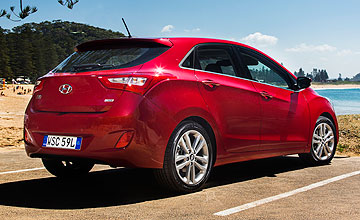BY BYRON MATHIOUDAKIS | 10th Apr 2015

Far from it, perhaps many of your friends, colleagues and family might applaud the sound reasoning behind the South Korean-built five-door hatchback’s purchase, from the obvious low price, still-attractive design and appealing interior practicality, to the dependable engineering, ease of operation, and excellent warranty and aftersales service.
Indeed, the i30 hatch is the every person’s small car nowadays. Line one up against its Toyota Corolla, Nissan Pulsar, Kia Cerato, Holden Cruze and Honda Civic equivalents, and the Hyundai’s broad attributes do tend to radiate.
But the car is blowing its third birthday candles right about now, and the better competition – if brought into this imaginary comparison – will show up deficiencies both minor and glaring.
Let us begin with the latter – an unsettled ride over anything other than ultra-smooth surfaces. To Hyundai’s credit, the i30 Series II launch saw us drive from Sydney north to the Wollombi national park, subjecting the volume-selling 1.8 Active X automatic on the journey up to some pretty cruddy roads.
Unfortunately, while the chassis sits planted at speed, the suspension struggles to iron out the bumps and ripples, while the Hankook 16-inch tyres weren’t backward coming forward with their vocal displeasure.
Furthermore, the electric power steering might have three settings – Comfort, Normal and Sport – but the first two modes are overly light, exacerbating the artificial feel of the helm, while the third just added more weight and effort.
At the straight-ahead position there is not enough sharpness, while through corners there is a lack of consistency, meaning the driver has to take more than one bite at the wheel to have it flowing through smoothly.
Additionally, the tubby i30 puts quite a lot of demands on the revvy but somewhat shouty 107kW/175Nm 1.8 four-pot petrol engine, undermining refinement.
Sadly no 124kW/201Nm 2.0 SR alternative was available for us to sample.
Switching over to the smoother 100kW/300Nm 1.6 CRDi turbo-diesel equivalent in the range-topping Premium for the drive back down to Sydney, and much of the same applies, except that – once the initial acceleration lag is overcome – that extra torque does really propel the oil-sipping i30 along at quite a rate of knots.
The new seven-speed DCT dual-clutch transmission is almost imperceptible in its operation, and the promised economy looks very appealing indeed.
Unfortunately, the Nexen 225/45R17 lower-profile tyres seemed to heighten the noise-intrusion and ride comfort maladies even more, making us wonder whether buyers needing to fork out around $35K for the flagship i30 diesel might not be better off looking elsewhere – not at least to the more resolved i40 mid-size sedan. Or, better still, the ubiquitous VW Golf, though the latest Peugeot 308 is proving to be a class-leading option too.
So, Hyundai’s best-seller probably works best as a value diesel proposition, although we did not try our hand at the base Active CRDi. We look forward to doing so, because the i30’s exceptionally effective dash, roomy and solid interior, handsome styling and generous warranty still make it a standout… even if only among the averages.
If all that is what matters to you most and you are an undemanding driver using smooth roads, then you ought to be very pleased with the slightly improved i30 Series II.